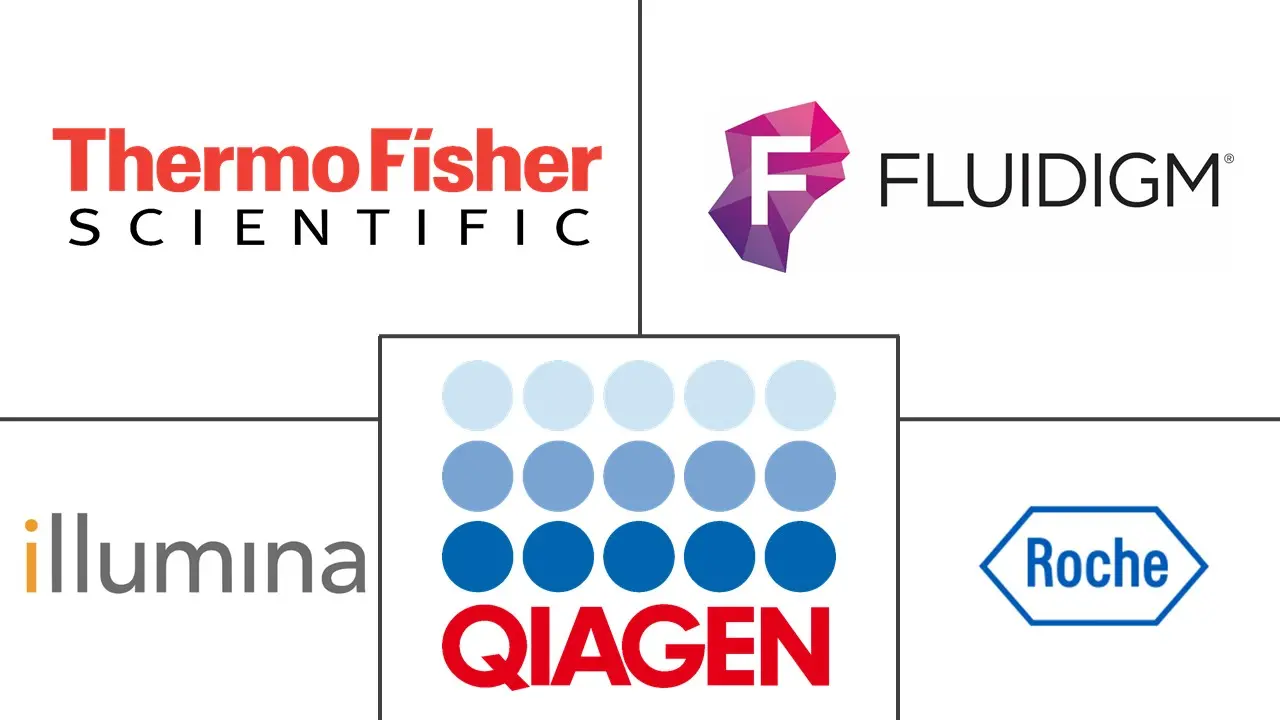Global Single-cell Genome Sequencing Market Size and Share
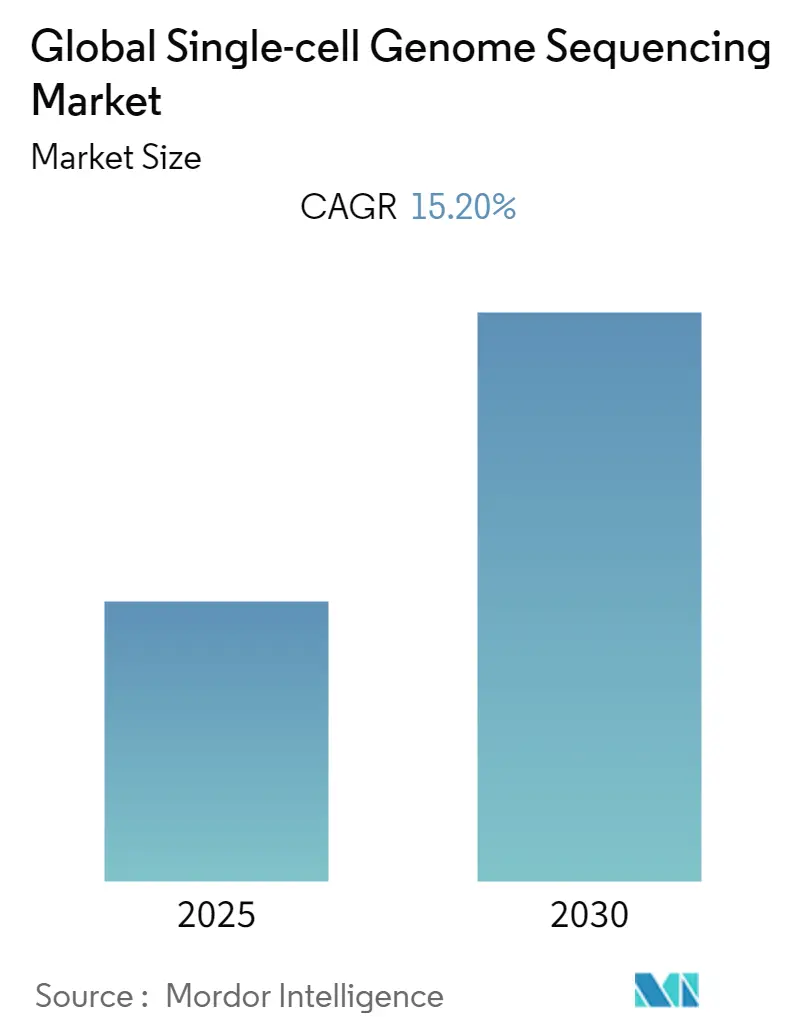
Global Single-cell Genome Sequencing Market Analysis by Mordor Intelligence
The single cell sequencing market was valued at USD 3.82 billion in 2024 and is forecast to reach USD 7.82 billion in 2030, advancing at a 15.4% CAGR during 2025-2030. Sustained cost declines, multi-omics integration, and rapidly widening clinical use cases have moved the technology from research curiosity to clinical necessity. Government-backed cell atlas programs, precision-oncology consortia, and combinatorial indexing methods that enable million-cell experiments are expanding the single cell sequencing market at every stage of the workflow. Technology vendors are broadening portfolios through mergers, acquisitions, and partnerships that tighten instrument-consumable-software linkages, while regulatory clarity in the United States and Europe accelerates translational projects. Bioinformatics talent shortages and high capital requirements still temper adoption, but workflow simplification and cloud analytics are lowering these barriers.
Key Report Takeaways
By product type, consumables led with 46.33% revenue share in 2024; instruments are projected to grow fastest at a 16.98% CAGR to 2030.
By sequencing technology, next-generation sequencing (NGS) held 69.05% of the single cell sequencing market share in 2024, whereas nanopore sequencing is poised for the highest growth at 17.17% CAGR through 2030.
By application, oncology accounted for 40.55% of demand in 2024, while immunology is advancing at a 17.36% CAGR to 2030.
By end user, academic and research institutes captured 56.65% of 2024 revenue, but pharmaceutical and biotechnology companies will expand fastest at 17.56% CAGR through 2030.
Global Single-cell Genome Sequencing Market Trends and Insights
Driver Impact Analysis
| Driver | (~) % Impact on CAGR Forecast | Geographic Relevance | Impact Timeline |
|---|---|---|---|
| Rapid decline in single-cell sequencing cost curve | +3.2% | Global, with early adoption in North America & Europe | Short term (≤ 2 years) |
| Surge in precision-oncology initiatives (e.g., Human Tumor Atlas) | +2.8% | North America & EU leading, APAC following | Medium term (2-4 years) |
| Integration of multi-omics single-cell platforms | +2.1% | Global, concentrated in major research hubs | Medium term (2-4 years) |
| Government-funded cell-atlas programs worldwide | +1.9% | Global, with China HGP2 and US initiatives leading | Long term (≥ 4 years) |
| Adoption of combinatorial indexing & in-situ genome sequencing | +1.8% | North America & EU core, spillover to APAC | Medium term (2-4 years) |
| CRISPR-based single-cell functional genomic screens | +1.6% | Global research centers, clinical translation emerging | Long term (≥ 4 years) |
| Source: Mordor Intelligence | |||
Rapid decline in single-cell sequencing cost curve
Per-cell costs have fallen from dollars to cents in under two years, allowing laboratories of all sizes to enter the single cell sequencing market[1]Source: St. Jude Children’s Research Hospital, “Imaging-based technique democratizes cell analysis,” phys.org . 10x Genomics’ Chromium system now analyzes cells at roughly USD 0.01 per cell, while the STAMP method from St. Jude Children’s Research Hospital cut immune-cell profiling costs for 1,000 individuals from USD 3.56 million to USD 75,000, slashing per-sample expenses by 47-fold. Instrument-free kits from ArgenTag eliminate upfront hardware costs and open new adoption channels. Together, these developments push routine single-cell studies beyond elite centers and into standard molecular-biology labs, expanding the single cell sequencing market’s installed base and recurring consumables revenue.
Surge in precision-oncology initiatives
Government-funded precision-oncology programs are generating large-scale biospecimen repositories that mandate high-resolution molecular profiling. FDA guidance on circulating tumor DNA issued in November 2024 formalized regulatory expectations for molecular diagnostics in curative-intent oncology trials[2]Source: Federal Register, “Use of circulating tumor DNA for solid-tumor drug development,” federalregister.gov. Illumina’s TruSight Oncology Comprehensive won FDA approval in August 2024, further normalizing genomic assays in clinical workflows. These milestones accelerate the translational pull-through of single-cell technologies for tumor heterogeneity mapping and therapy selection, intensifying demand in the single cell sequencing market.
Integration of multi-omics single-cell platforms
Platforms such as ECCITE-seq quantify transcripts, proteins, clonotypes, and CRISPR edits simultaneously, giving researchers multidimensional views of cellular states. BioSkryb Genomics and Tecan now deliver whole-genome and whole-transcriptome libraries in under 10 hours. Scale Biosciences and BioLegend’s TotalSeq Phenocyte solution introduces quantum barcodes that support hundreds of protein measurements per cell. Collectively, such integrated offerings heighten the single cell sequencing market’s value proposition by minimizing batch effects and cutting sample input requirements.
Government-funded cell-atlas programs worldwide
Japan’s Omics Browser integrates multi-omics data from 1,405 individuals with planned scRNA-seq expansion. China’s Human Genome Project II will analyze genomes from 80 million people, driving vast instrument and consumable demand. The US Human BioMolecular Atlas Program is mapping healthy reference tissues to the cell level. Standardized protocols emerging from these initiatives lower analytical variability, encourage data sharing, and guarantee multi-year budget allocations that underpin long-term growth for the single cell sequencing market
Restraint Impact Analysis
| Restraint | (~) % Impact on CAGR Forecast | Geographic Relevance | Impact Timeline |
|---|---|---|---|
| High capital & consumable expenditure | -2.4% | Global, particularly affecting emerging markets | Short term (≤ 2 years) |
| Bioinformatics talent & data-analysis bottlenecks | -1.8% | Global, acute in APAC and emerging regions | Medium term (2-4 years) |
| Fragmented microfluidic IP driving licensing costs | -1.2% | North America & EU primarily | Medium term (2-4 years) |
| Coverage-bias in sample prep limiting clinical uptake | -0.9% | Global clinical laboratories | Long term (≥ 4 years) |
| Source: Mordor Intelligence | |||
High capital & consumable expenditure
Although per-cell sequencing costs are falling, the instruments still command six-figure list prices. 10x Genomics reported a 46% drop in instrument revenue to USD 19.1 million in Q3 2024 as customers delayed purchases, even as consumables grew 10% to USD 126.2 million. Regulatory proposals for Laboratory Developed Tests could impose up to USD 3.56 billion annually in compliance costs, straining clinical-lab budgets. Kits from Parse Biosciences and ArgenTag lower reagent spend but still require extensive validation, delaying immediate relief.
Bioinformatics talent & data-analysis bottlenecks
Single-cell projects generate terabyte-scale datasets that demand advanced computational pipelines. Eleven unresolved challenges—from batch-effect correction to multimodal integration—require specialist skills in statistics and software engineering. FastDE accelerates differential-expression analysis 50-fold, but cloud GPU clusters remain scarce in resource-limited regions biorxiv.org. The talent gap widens in APAC where bioinformatics curricula lag behind wet-lab adoption, creating regional disparities in single cell sequencing market penetration.
Segment Analysis
By Product Type: Installed-Base Expansion Spurs Instrument Growth
Consumables generated 46.33% of 2024 revenue, underscoring the annuity-style engine that fuels the single cell sequencing market. Laboratories consume barcoded beads, enzymes, and specialty plastics with every experiment, guaranteeing steady demand regardless of macro cycles. Instruments, while accounting for a smaller proportion of sales, are set to rise at a 16.98% CAGR thanks to spatial-omics upgrades and modular add-ons that raise throughput and resolution. 10x Genomics noted that its spatial instruments already out-earn Chromium sequencers in new placements, indicating a clear pivot toward integrated imaging-sequencing platforms. Singular Genomics’ G4X Spatial Sequencer merges RNA, targeted panels, and protein detection to cut run times and reagent costs, appealing to overstretched core facilities. Oxford Nanopore’s Mk1D and upcoming ElysION automate library prep and analysis, shrinking the workflow footprint and lowering training needs. Software and services, although still nascent, are benefiting from subscription-based analytics, which bundle pipeline maintenance, visualization dashboards, and compliance reporting. Vendors that embed AI-powered quality control and cloud scalability position their offerings as end-to-end ecosystems, improving switching costs and stabilizing the single cell sequencing market.
Meanwhile, consumables will sustain mid-teens growth as every new instrument unlocks recurring reagent demand. Vendors pivoting toward kit-agnostic hardware risk margin compression, whereas fully integrated suppliers can preserve premium pricing through reagent pull-through. Competitive differentiation now hinges on ease-of-use, automation, and flexible throughput rather than raw read depth, indicating a paradigm shift in buyer evaluation criteria.
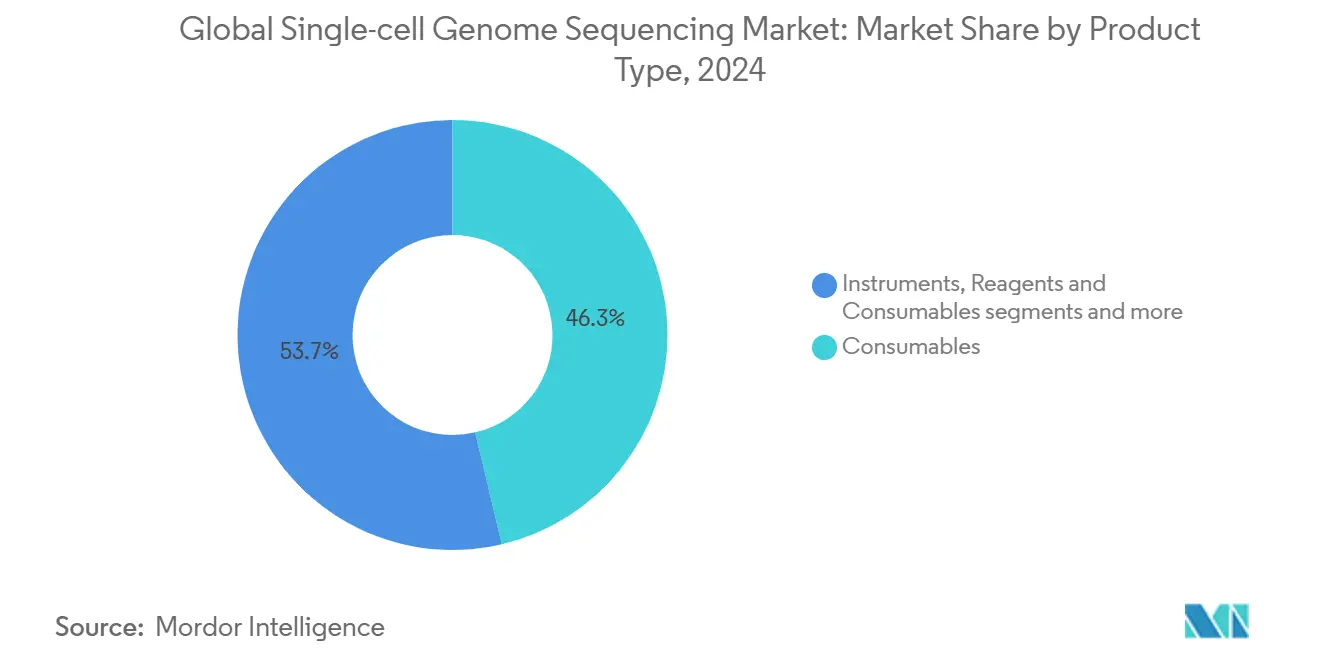
Note: Segment shares of all individual segments available upon report purchase
By Sequencing Technology: Nanopore Platforms Challenge NGS Dominance
Next-generation sequencing held 69.05% of single cell sequencing market share in 2024, but its grip is loosening as nanopore methods scale and improve accuracy. Nanopore devices provide real-time reads, long-range phasing, and lower capital costs, making them ideal for structural-variant detection and point-of-care testing. The technology’s 17.17% projected CAGR outpaces NGS as oncology and infectious-disease workflows demand rapid turnaround. Oxford Nanopore has cut system cost to sub-USD 1,000 handheld options, widening user access. AI-driven base-calling and the open SLOW5 data format reduce compute time from weeks to hours, tackling historic accuracy limitations.
Single-molecule real-time (SMRT) sequencing and other emerging chemistries remain niche, addressing ultra-long reads or epigenetic modifications in specialized studies. However, integration of SMRT with combinatorial indexing could unlock million-cell long-read datasets, blurring lines between single-cell and bulk platforms. Market leaders are hedging against disruption by partnering with nanopore vendors or releasing their own hybrid kits. The single cell sequencing industry therefore faces technology pluralism, where laboratories maintain multi-platform fleets tailored to distinct research questions.
By Application: Immunology Rises on Therapeutic Pipeline Demand
Oncology remained the largest use case at 40.55% in 2024, leveraging single-cell data for tumor heterogeneity, clonal evolution, and therapy resistance studies. Yet immunology is accelerating at a 17.36% CAGR because cell-therapy developers require granular T-cell receptor and cytokine profiles to optimize CAR-T constructs. Multi-omics readouts that combine transcriptomics with surface-protein barcodes inform potency assays and safety assessments. The Brain Cell Atlas, comprising 26.3 million cells from 70 human and 103 mouse datasets, illustrates the neurological segment’s potential, offering granular maps for neurodegenerative drug discovery. Infectious-disease programs apply metagenomic approaches to identify rare pathogens in sepsis or emerging outbreaks without culturing steps.
Downstream, artificial-intelligence models extract cell-state trajectories, enabling virtual screening of therapeutic targets. As a result, immunology datasets are projected to reach 25% of the single cell sequencing market by 2030. Vendors offering end-to-end immuno-profiling kits with validated antibody panels and turnkey pipelines stand to capture disproportionate share of new budgets.
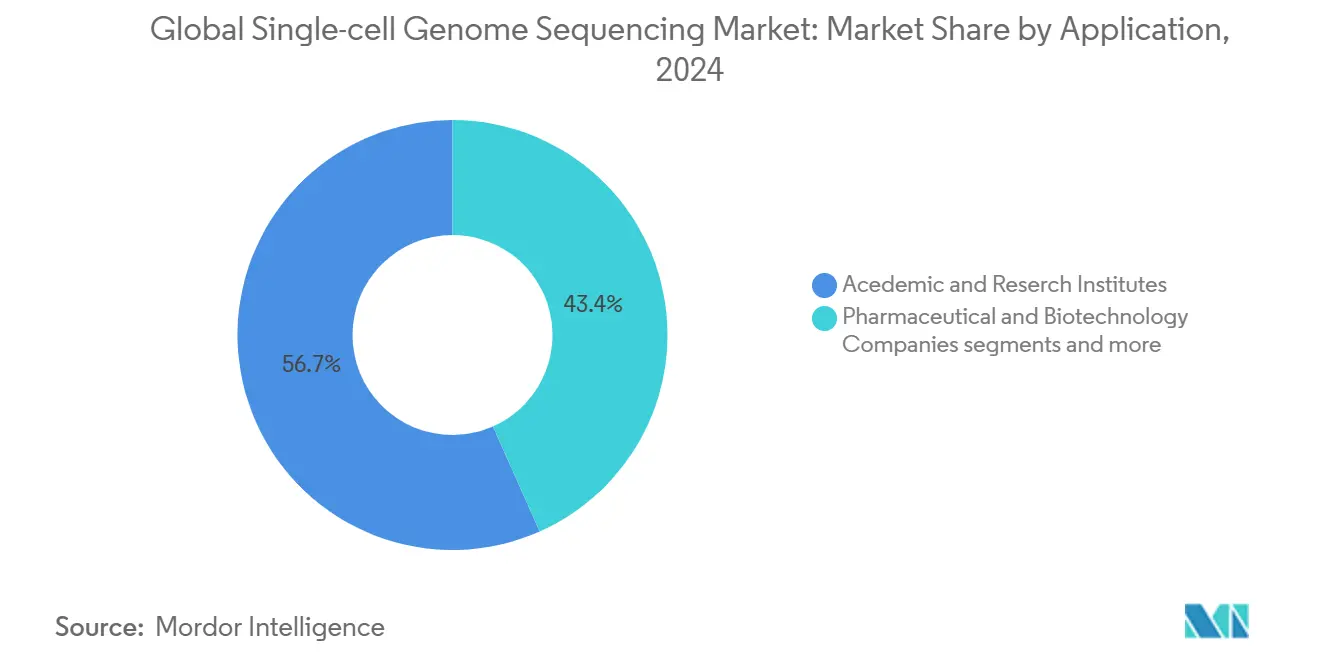
Note: Segment shares of all individual segments available upon report purchase
By End User: Pharma Adoption Signals Commercial Maturity
Academic and research institutes contributed 56.65% of 2024 demand, but pharma and biotech firms will expand at 17.56% CAGR as single-cell data become drug-discovery staples. Biopharma currently represents only 15-20% of 10x Genomics revenue, yet the company targets 50% contribution by 2030, reflecting pipeline integration goals. Contract research organizations (CROs) benefit downstream as sponsors outsource multi-omics projects to specialized service laboratories. Clinical labs, hampered by capital costs and regulatory overhead, will scale more slowly but could prove pivotal once reimbursement codes finalize.
The single cell sequencing market size for pharmaceutical and biotechnology companies is projected to surge to 17.56 % from 2025 to 2030, reflecting deeper penetration into discovery, toxicology, and companion-diagnostic programs. Vendors that develop validated assays, Good Laboratory Practice–compliant instruments, and secure cloud environments will be best placed to serve this customer segment.
Geography Analysis
North America commanded more than 40% of 2024 revenue, anchored by sustained National Institutes of Health funding, a vibrant venture-capital ecosystem, and early FDA approvals of sequencing-based diagnostics. The Human Tumor Atlas Network, Broad Institute, and Stanford’s Chan Zuckerberg Biohub act as regional magnets for global talent. Despite a modest 11% revenue decline in the Americas for 10x Genomics during Q3 2024, the company still serves 1,800 academic customers and 287 pharmaceutical partners, underscoring entrenched demand. Growth is now shifting from purely grant-funded labs to integrated health-system networks exploring liquid-biopsy tests that rely on single-cell reference libraries.
Europe holds the second-largest regional position, buoyed by Horizon Europe grants and a strong biopharmaceutical industry. Illumina successfully navigated EU regulatory frameworks to secure pan-European approvals for its oncology panels in 2024, a milestone that encourages hospital genomic centers to adopt companion single-cell assays. WhiteLab Genomics raised USD 10.2 million in Series A funding to broaden its AI-driven single-cell analytics, highlighting Europe’s edge in computational biology.
Asia-Pacific is the fastest-growing territory, projected at 20%+ CAGR through 2030. The region benefits from mega-projects such as China’s Human Genome Project II and Japan’s Omics Browser. 10x Genomics posted 15% APAC revenue growth in Q3 2024, driven by increased instrument placements and consumable pull-through. BGI Group offers a regional alternative to Western platforms, although benchmarking studies show performance parity rather than superiority to Illumina systems. Trade-policy friction and export controls remain headwinds, potentially slowing technology exchange and contributing to bifurcated.
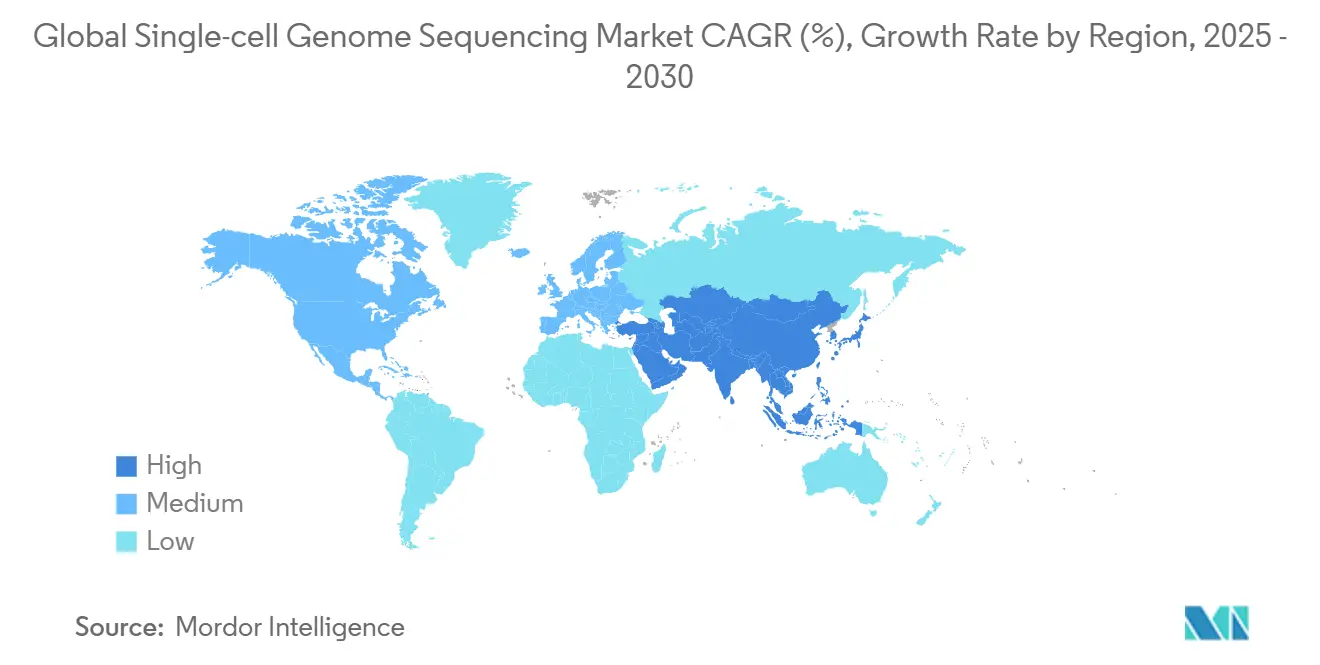
Competitive Landscape
The single cell sequencing market is moderately fragmented, with top players holding overlapping but distinct competitive levers. Illumina leads in NGS chemistry and distribution channels but has expanded into single-cell sample prep through its July 2024 acquisition of Fluent BioSciences, which offers microfluidics-free PIPseq kits. 10x Genomics retains the largest consumables portfolio and seeks to double pharma revenue share by 2030 through dedicated translational-research programs. Oxford Nanopore has positioned its portable MinION and full-scale PromethION systems as real-time, long-read complements to NGS, targeting infectious-disease and structural-variant markets.
Strategic partnerships shape ecosystem boundaries. BioSkryb Genomics allies with Tecan to combine ResolveOME chemistry and Uno Single Cell Dispenser hardware, cutting library prep to under 10 hours. Scale Biosciences’ quantum-barcode chemistry integrated with BioLegend’s 400-antibody panel positions the duo for high-parameter protein profiling, critical in immuno-oncology.
Consolidation pressures surfaced in December 2024 when Deerfield Management agreed to acquire Singular Genomics for USD 20.00 per share, a 254% premium over market price, giving the platform private-market runway to refine spatial assays without quarterly-earnings scrutiny. With large incumbents still below 25% combined revenue share, further M&A is likely as vendors seek end-to-end solutions, regional distribution advantages, or specialized chemistries.
Global Single-cell Genome Sequencing Industry Leaders
-
QIAGEN
-
Fluidigm Corporation
-
Illumina, Inc.
-
F. Hoffmann-La Roche Ltd.
-
ThermoFisher Scientific, Inc.
- *Disclaimer: Major Players sorted in no particular order
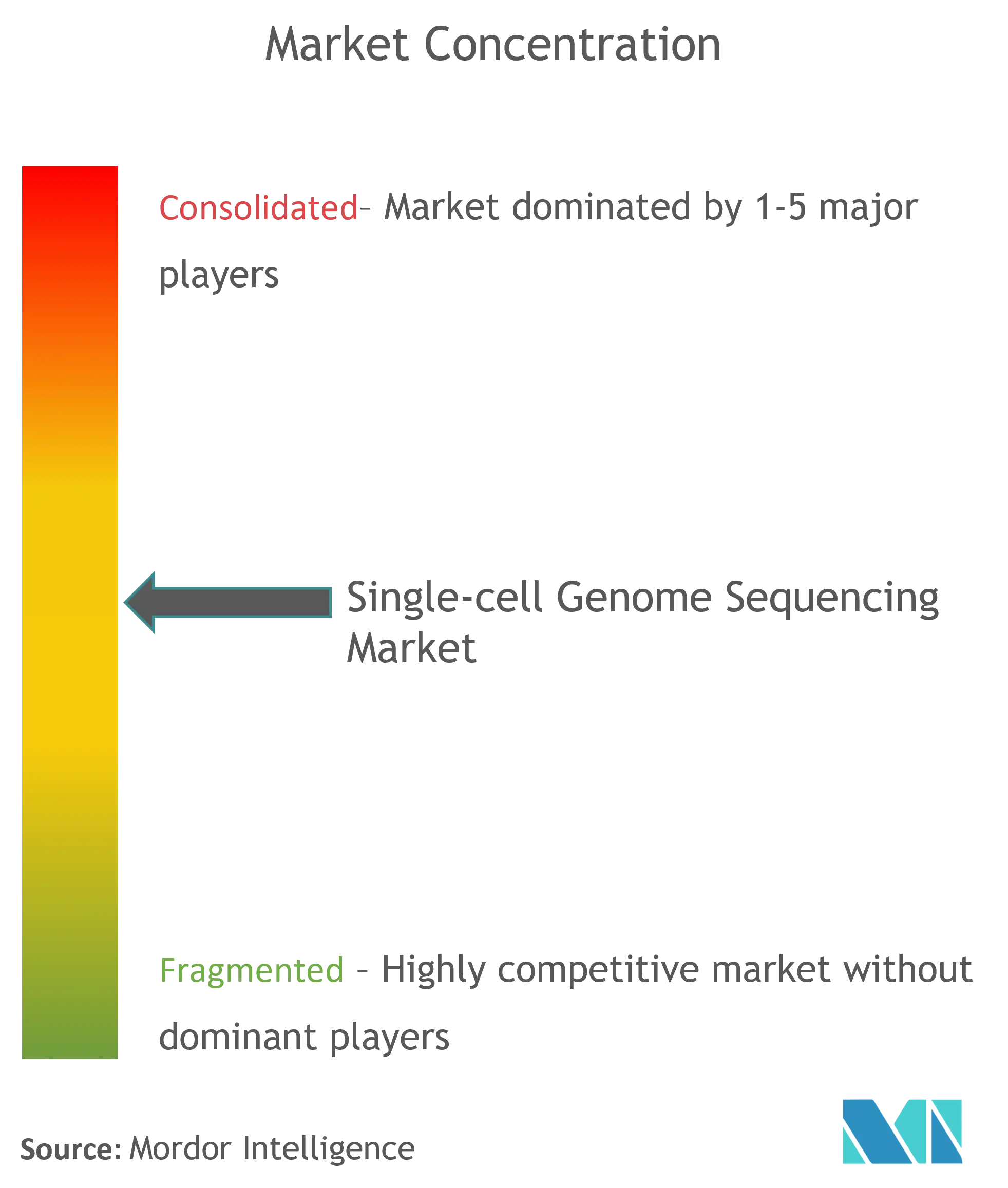
Recent Industry Developments
- January 2025: MaxCyte acquired SeQure Dx for USD 4.5 million plus earn-outs to offer ON-TARGET-Seq and GUIDE-Seq assays that verify CRISPR edits.
- December 2024: Deerfield Management moved to acquire Singular Genomics for USD 20.00 per share, valuing the company at a 254% premium.
Global Single-cell Genome Sequencing Market Report Scope
According to the scope, single-cell genome sequencing involves isolating a single cell, performing whole-genome-amplification (WGA), constructing sequencing libraries, and then sequencing the DNA using a next-generation sequencer. The Single-cell Genome Sequencing Market is Segmented by Product (Instruments and Reagents), Technology (Sequencing, PCR, Microarray, and Others), Disease Area (Cancer, Immunology, Microbiology, and Others), End User (Biotechnology & Biopharmaceutical Companies, Clinics, and Others), and Geography (North America, Europe, Asia-Pacific, Middle-East and Africa, and South America). The market report also covers the estimated market sizes and trends for 17 countries across major global regions. The report offers the value (in USD million) for the above segments.
| Instruments |
| Reagents & Consumables |
| Software & Services |
| Next-Generation Sequencing |
| Single-Molecule Real-Time (SMRT) Sequencing |
| Nanopore Sequencing |
| Other Emerging Methods |
| Oncology |
| Immunology |
| Neurology |
| Microbiology & Infectious Disease |
| Developmental Biology |
| Others |
| Academic & Research Institutes |
| Pharmaceutical & Biotechnology Companies |
| Clinical & Diagnostic Laboratories |
| Contract Research Organizations (CROs) |
| North America | United States |
| Canada | |
| Mexico | |
| Europe | Germany |
| United Kingdom | |
| France | |
| Italy | |
| Spain | |
| Rest of Europe | |
| Asia-Pacific | China |
| India | |
| Japan | |
| South Korea | |
| Australia | |
| Rest of Asia-Pacific | |
| South America | Brazil |
| Argentina | |
| Rest of South America | |
| Middle East and Africa | GCC |
| South Africa | |
| Rest of Middle East and Africa |
| By Product Type | Instruments | |
| Reagents & Consumables | ||
| Software & Services | ||
| By Sequencing Technology | Next-Generation Sequencing | |
| Single-Molecule Real-Time (SMRT) Sequencing | ||
| Nanopore Sequencing | ||
| Other Emerging Methods | ||
| By Application | Oncology | |
| Immunology | ||
| Neurology | ||
| Microbiology & Infectious Disease | ||
| Developmental Biology | ||
| Others | ||
| By End User | Academic & Research Institutes | |
| Pharmaceutical & Biotechnology Companies | ||
| Clinical & Diagnostic Laboratories | ||
| Contract Research Organizations (CROs) | ||
| By Geography | North America | United States |
| Canada | ||
| Mexico | ||
| Europe | Germany | |
| United Kingdom | ||
| France | ||
| Italy | ||
| Spain | ||
| Rest of Europe | ||
| Asia-Pacific | China | |
| India | ||
| Japan | ||
| South Korea | ||
| Australia | ||
| Rest of Asia-Pacific | ||
| South America | Brazil | |
| Argentina | ||
| Rest of South America | ||
| Middle East and Africa | GCC | |
| South Africa | ||
| Rest of Middle East and Africa | ||
Key Questions Answered in the Report
Q1. What is the projected value of the single cell sequencing market in 2030?
A1. The market is forecast to reach USD 7.82 billion by 2030, expanding at a 15.4% CAGR during 2025-2030.
Q2. Which product category is growing fastest?
A2. Instruments are expected to rise at a 16.98% CAGR as laboratories invest in spatial-omics and integrated multi-omics platforms.
Q3. Why is nanopore sequencing gaining traction?
A3. Nanopore devices provide real-time, long-read data with lower hardware costs, supporting rapid clinical and field applications and therefore outpacing NGS growth at a 17.17% CAGR.
Q4. Which application area is expanding most rapidly?
A4. Immunology is growing at 17.36% CAGR because drug developers rely on single-cell profiling for CAR-T and checkpoint-inhibitor programs.
Page last updated on:
